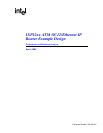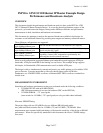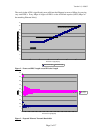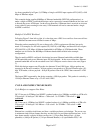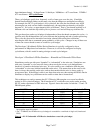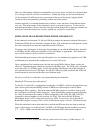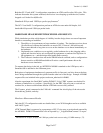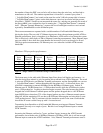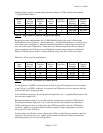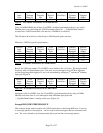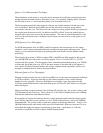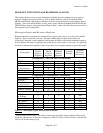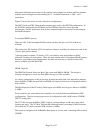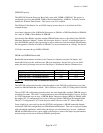
Version 1.0, 4/10/02
Page 6 of 17
As shown graphically in Figure 3, 622Mbps of single-cell-PDU input requires 622*(84/55) = 949
Mbps of Ethernet output.
This example design supplies 800Mbps of Ethernet bandwidth (IXP1240 configurations), so
under a single cell/PDU workload the design can be expected to transmit Ethernet at line rate, and
to discard the excess ATM input. In the reverse direction, if Ethernet data is received at wire rate
(even with all 8 ports running at wire-rate), ATM transmit will not be saturated under a single
cell/PDU workload.
Multiple Cells/PDU Workload
Following Figure 2 from left to right, it is clear that once a PDU size overflows from one cell into
two, Ethernet becomes more efficient in terms of Mbps.
When the packet completely fills two or three cells, ATM is again more efficient, but not by
much. For example, two full cells require 622(118/110) = 666 Mbps; and three full cells require
622/(166/159) = 625 Mbps of Ethernet bandwidth for 622Mbps of ATM bandwidth. These
numbers are well below the 800Mbps of Ethernet bandwidth available in the example
configuration.
Thus for multi-cell/PDU workloads, this design has more Ethernet bandwidth available than
ATM bandwidth, and excess Ethernet input will be discarded. In the reverse direction, Ethernet
transmit bandwidth will not be exceeded even if all ATM ports receive data at wire-rate (Figure
3).
While this design supports any IP packet size between 20 and 1500 bytes, 40 byte packets are
expected to be the most common. 40-byte packets corresponds to a 20-byte IP header plus a 20-
byte TCP header, with no payload. 40-byte IP packets form AAL5 PDUs that consume 2 ATM
cells.
The largest PDU supported by the design contains a 1500-byte packet. This packet is carried by a
1518-byte Ethernet frame or by a 32-cell AAL5 PDU.
CYCLE AND INSTRUCTION BUDGETS
Cycle Budgets to support Line Rates
OC-12 line rate is 622Mbps, but SONET overhead reduces it to 599Mbps available to ATM cells.
53 bytes/cell * 8 bits/byte / 599 Mb/sec = 708 ns/cell. So 232MHz * 708 ns/cell = 164
cycles/cell.
OC-3 line rate is 155Mbps, but SONET overhead reduces it to 149Mbps available to ATM cells.
53 bytes/cell * 8 bits/byte / 149 Mb/sec = 2.85 us/cell. So 232MHz * 2.85 us/cell = 660
cycles/cell.
Ethernet has a variable sized frame, and thus a variable per-frame cycle budget. The worst-case
is minimum-sized 64-byte frames, thus they are the focus for per-frame calculations here. A 64-
byte frame actually occupies 84 bytes on the wire. {(12 byte Inter Packet Gap) + (8 byte
preamble) + (46 byte IP packet) + (14 byte Ethernet Header) + (4 byte Ethernet FCS) = 84



